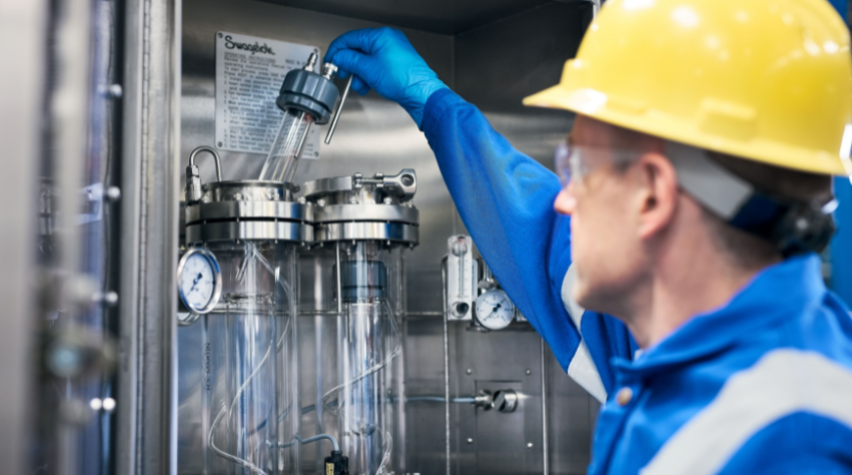
Disclosure: This post is sponsored by Swagelok Company and reflects their views, opinions, and insights.
Requiring significant safety precautions and specific conditions, anhydrous ammonia is notoriously tricky to sample. But new technological improvements have made the process safer and simpler for chemical plants and refineries.
Anhydrous ammonia is a commonly used chemical in the production of fertilizers, plastics, textiles, petroleum, and more. But in order to prevent potentially severe corrosion and product quality concerns, ammonia used in these applications must typically maintain water content between 0.2% and 0.5%
Maintaining such precise water content is a process of continuous evaluation and regular testing. The process of testing ammonia, though, can be an arduous one. Technicians must use the necessary personal protective equipment (PPE) to carry out the procedure. Testing itself is a careful and lengthy procedure – the process can take hours, and even slight missteps can alter the sample’s representativeness.
But recent technological advancement can make the ammonia sampling process simpler and efficient. Read on to learn more about why the traditional methods for sampling ammonia can be time-consuming and costly, and how specifically designed ammonia sampling systems can alleviate some of these complications while enhancing safety, accuracy, and efficiency in your facility.
Evaluating common ammonia sampling techniques
First, it is important to understand why accurate measurement of water content is so critical.
Water concentrations lower than 0.2% can lead to a greater likelihood of ammonia stress corrosion cracking in critical parts of the fluid system. This is a particularly dangerous phenomenon – stress corrosion cracking can destroy a component at stress levels below an alloy’s expected yield strength, and final failure can occur suddenly and without warning. Meanwhile, water content in excess of 0.5% can yield suboptimal end products.
A process known as the CGA G-2.2 method is the most common technique for determining water concentration in ammonia. Here, a 100 mL sample of liquid ammonia is drawn and allowed to evaporate. The residual water from the evaporated sample indicates the water content. If the content falls outside of the 0.2% to 0.5% range, operators should take steps to make the appropriate corrections.
But the CGA G-2.2 process does not always guarantee accurate measurement. Several variables can cause interference, including:
- Inadequate flushing of residual water can cause old material from the transport line can interfere with the representativeness of the sample.
- As cold ammonia fills warm glass containers, it immediately begins to boil and evaporate, making it difficult to fill residue tubes to the graduation line.
- Inconsistent rates of heating can lead to inconsistency in sample results.
In addition to these issues, the manual process of handling ammonia can be a challenge. The process must be performed with precision to fill a warm residue tube just as ammonia boils off. Manual sampling procedures also require up to 8 hours before a measurement can be taken.
Safety is another critical consideration. Because anhydrous ammonia is highly toxic, great care must be taken to protect operators and the environment. Ammonia can cause severe burns and eye irritation, requiring PPE for safe handling. Operators must also be exceedingly careful not to spill the substance.
A better way to sample ammonia
Traditional ammonia sampling processes can be cumbersome, time-consuming, and prone to error – but with established technology and engineering expertise, a better way is possible.
For example, pre-engineered grab sampling systems have established themselves as a good choice for the safe and reliable sampling of many different industrial fluids. And today, grab sampling systems specifically designed for ammonia sampling are available from certain suppliers. The beneficial design features of such a system may include:
- Chilling mechanisms that can help minimize the potential for excessive boiling. Ammonia boils off quite easily and can threaten fill accuracy.
- Closed-sample design that can help improve safety by limiting operator exposure and environmental impact. A closed-sample design reduces the need for significant amounts of PPE. Closed sample fixtures may also be made of glass, allowing the operator to monitor conditions inside the system.
- Semi-automated dispensing that can assist with the filling process, helping to ensure consistent sample sizes during each use. For example, a cap assembly can be fitted to the residue tube to assist in filling sample tubes to the appropriate levels.
- User-friendly operation can prevent errors that interfere with accuracy. For instance, a geared mechanism may enable the operator to easily choose between different functions.
Systems specifically designed for ammonia sampling can help improve safety by minimizing the operator’s exposure to liquid and vaporized ammonia. They can also enhance consistency in operation and expedite the sampling process significantly. And they can improve overall efficiency by reducing sampling time, improving user operability, and reducing the potential for human error.
As such, ammonia-specific sampling systems are well worth investigating for industrial professionals who work with the substance on a regular basis. Your vendors may be able to point you in the right direction. Talk with your suppliers to learn more about how these systems can immediately benefit your operations.
 Matt Dixon
Matt Dixon
Matt Dixon is Application Commercialization Manager for Swagelok Company. He began his career with the company in 1998 as an engineering co-op student and has worked as an assembly, welding, and manufacturing engineer in an array of capacities since, supporting the production of various product lines and the designing and building of assembly and test equipment. Read more.
Disclosure: This post is sponsored by Swagelok Company and reflects their views, opinions, and insights.



Comments
Did an unusual first job as ChemE a ammonia "fueled" hydrogen generator for the US Army !